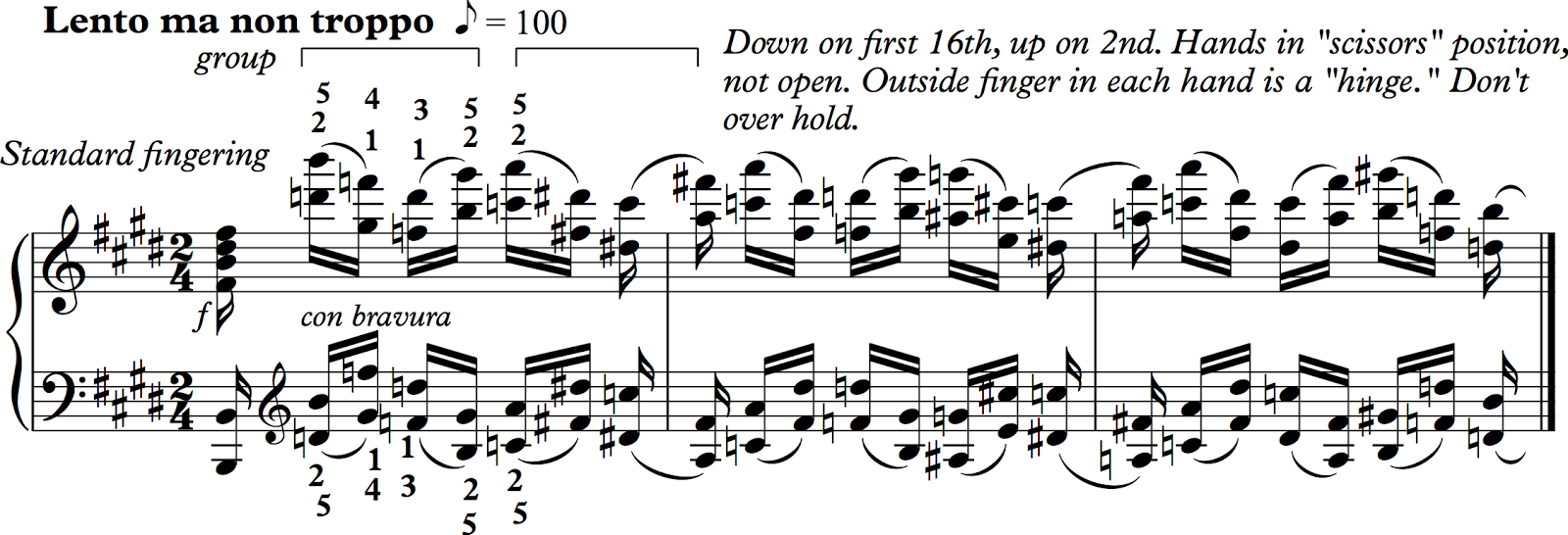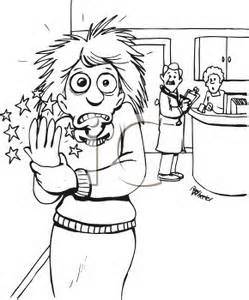Amazon has had problems setting up the "Look Inside" feature for these titles, problems we're expecting to solve soon. In the meantime, as some readers have requested, here are some sample pages. Excerpts from the introduction can be found elsewhere in this blog. The levels of difficulty range from early intermediate to advanced and include left-hand studies along with scales, arpeggios, leaps and virtually all manner of technical necessities. The examples are from Bach, Haydn, Mozart, Chopin, etc. I've included one example of a practice guide, of which, along with practice hints, there are several throughout the volume. The Index is at the bottom of the page.
Click on the example to enlarge.
Alberti............... 19, 31, 40, 42, 44, 55, 65, 124, 155, 172, 222
Arpeggios 23, 26, 40, 41, 99, 103, 109, 131, 143, 152, 156, 173, 193, 200,
213, 215
Art of Finger Dexterity, The................................................................ 7
Articulation............................................................................... 27,
106
Bach, J.S.
Invention in A minor.............................................................. 13
Invention in C Major............................................................... 12
Invention in F Major............................................................... 31
Well Tempered Clavier Bk. I
Prelude in D Major............................................................. 62
Beethoven, L.
Op. 10, No. 1
Allegro..................................................................................... 101
Finale........................................................................................ 107
Op. 10, No. 3.............................................................................. 119
Rondo...................................................................................... 125
Op. 110
Morsel...................................................................................... 241
Op. 13............................................................................................ 111
Op. 13, Pt. 2................................................................................ 113
Practice Guide..................................................................... 118
Op. 14, No. 1.............................................................................. 131
Op. 2, No. 1
Prestissimo............................................................................ 103
Op. 2, No. 3................................................................................ 158
Trio.............................................................................................. 99
Op. 22..................................................................................... 25,
156
Allegro........................................................................................ 89
Op. 26............................................................................................ 150
Rondo...................................................................................... 162
Op. 27, No. 1.............................................................................. 165
Rondo...................................................................................... 140
Op. 27, No. 2.............................................................................. 173
Op. 31, No 1............................................................................... 146
Op. 53
Allegro..................................................................................... 181
Op. 53............................................................................................ 152
Op. 54............................................................................................ 135
Op. 57............................................................................................ 176
Andante................................................................................... 170
Morsel............................................................................ 234,
239
Op. 76 "Ruins of Athens"
Variation 1.............................................................................. 124
Variation 5.............................................................................. 123
Op. 81a
Wiedersehen........................................................................ 143
Op. 81a Allegro
Morsel...................................................................................... 242
Op. 90............................................................................................ 222
Variations "Venni amore" 1790
Variation 1................................................................................ 22
WoO 80 C Minor Variations
Variation 22........................................................................... 134
Variation 26........................................................................... 129
Variation 27........................................................................... 129
Variation 28........................................................................... 149
Variation 4................................................................................ 78
Variation 5.............................................................................. 102
Variation 6................................................................................ 85
Variation 7................................................................................ 43
Variation 8.............................................................................. 122
Variation 9.............................................................................. 161
Variations 1-3........................................................................ 109
Variations 14, 16.................................................................. 130
Brahms
Letter................................................................................................... 8
broken arpeggios.......................................................................... 155
Broken Octaves.................................................. 98,
119, 143, 158
Broken Sixths.................................................................................. 119
cantabile style.................................................................................... 18
Chopin, F.
Ballade in F Minor
Practice Guide..................................................................... 206
Ballade in F Minor, Op. 52................................................ 200
Ballade in G Minor
Practice Guide..................................................................... 228
Ballade in G Minor Coda................................................... 229
Practice guide...................................................................... 233
Ballade in G Minor Op. 23...................................... 213,
224
Berceuse Op. 57............................................................ 194,
221
Leaps......................................................................................... 167
Etude Op. 10, No. 12
Morsel............................................................................ 234,
236
Etude Op. 10, No. 4
Morsel...................................................................................... 235
Etude Op. 10, No. 8
Morsel...................................................................................... 238
Nocturne
Op. 27, No. 1........................................................................ 193
Nocturne Op. 27, No. 2
Morsel............................................................................ 237,
238
Prelude Op. 28, No. 3
Left Hand............................................................................... 139
Scherzo in C-Sharp Minor, Op. 39............................... 215
Sonata in B-Flat Minor
Alternate.................................................................................. 198
Sonata in B-Flat Minor, Op. 35........................................ 196
Chords...................................................................................... 200,
221
Clementi, Muzio................................................................................ 7
Complex Rhythm......................................................................... 108
Coordination 55, 58, 78, 85,
123, 124, 125, 150, 188, 189, 215
Coordination).................................................................................... 71
Counterpoint.................................................................................. 134
Invention in A Minor.............................................................. 13
Invention in C Major............................................................... 12
Invention in F.............................................................................. 31
Czerny, Carl.......................................................................................... 7
Davidsbündlertänze.................................................................... 169
Dotted Rhythm.............................................................................. 101
Double Notes. 111, 122, 129,
135, 168, 194, 200, 211, 242
Fingering................................................................ 71,
110, 193, 237
Forearm rotation.............................................................. 9,
39, 111
fortepiano............................................................................................ 18
four-against-three.......................................................................... 108
Gradus ad Parnassum........................................................................... 7
Group.................................................................................................... 10
Grouping....................................................................... 139,
236, 238
Hand Division................................................................................ 198
hands separately............................................................................... 11
Haydn, Joseph
Hob. XVI/23................................................................................ 81
Hob. XVI/27................................................................. 17,
18, 19
Variation 1................................................................................ 20
Hob. XVI/28................................................................................ 23
Variation 4................................................................................ 34
Hob. XVI/30................................................................................ 48
Variation 3................................................................................ 35
Variation 5................................................................................ 36
Hob. XVI/31................................................................................ 95
Hob. XVI/39......................................................................... 16,
42
Hob. XVI/8................................................................................... 15
Sonata 1785
Variation I................................................................................. 30
hinge.................................................................................................... 108
in 110
In/Out................................................................................................ 139
independence of fingers.............................................................. 8
inventions............................................................................................ 39
Leaps................................................................................... 79,
129, 167
Left Hand 21, 25, 41, 43, 54, 71, 76, 79, 98, 103, 122, 139, 140, 142,
149, 156, 170, 181, 189, 193, 196, 222
Lhevinne, Rosina............................................................................... 7
Liszt, F.
Concerto in E-Flat
Morsel...................................................................................... 243
Loesser, Arthur................................................................................... 8
Morsel..................................... 234,
235, 236, 237, 238, 239, 243
Moszkowski.......................................................................................... 8
Mozart, W.A.
K. 208
Variation 1................................................................................ 53
K. 265
Variation 7................................................................................ 75
K. 265 "Ah, vous dirai-je"
Variation 1................................................................................ 33
Variation 2................................................................................ 54
Variation 3................................................................................ 27
Variation 4................................................................................ 41
Variation 6................................................................................ 21
K. 279................................................................................................ 37
K. 280................................................................................................ 44
K. 309................................................................................................ 58
K. 310........................................................................................ 73,
76
Allegro maestoso.................................................................. 71
Presto.......................................................................................... 79
K. 331........................................................................................ 55,
56
K. 332................................................................................................ 65
K. 333................................................................................................ 86
K. 455 "Unser dummer Poebel"
Variation 1................................................................................ 28
Variation 2................................................................................ 98
K. 500
Variation 1.............................................................................. 106
Variation 2.............................................................................. 142
Variation 3................................................................................ 24
K. 545................................................................................. 26,
29, 40
Octaves... 43, 55, 56, 102, 119, 130, 134, 135, 140, 143, 158
out……………………………………………...110
Paganini................................................................................................... 7
Parallel............................................................................. 125,
146, 165
Practice Guide....... 18, 39,
64, 118, 188, 206, 210, 228, 233
Practicing............................................................................................. 10
Repeated Notes............................................................ 86,
109, 110
rotate.................................................................................................... 118
Rotation................................................................................................... 9
Scales 19,
29, 31, 35, 42, 44, 58, 65, 73, 75, 81, 86, 95, 107, 143, 146
School of Velocity, The........................................................................... 7
Schumann, R.
Critic.................................................................................................... 8
Fantasy Op. 17........................................................................... 211
Kreisleriana Practice Guide.............................................. 210
Kreisleriana, Op. 16, Agitatissimo.................................. 208
Op. 6, No. 6................................................................................ 168
Shape............................................................................................ 10,
188
Staccato.................................................................................................. 85
strength training................................................................................. 8
Thirds.................................................................... 129,
130, 200, 242
Thumb on Black Keys................................................................. 56
tremolo............................................................................................... 108
Trills..................................................... 27,
106, 142, 150, 161, 181
Triplets................................................................................... 16,
17, 58
Two Against Three...................................................................... 142
Two-Note Slurs.............................................................. 30,
53, 106
Voicing........................................................................... 167,
170, 221
walking arm........................................................................................ 10
weight.................................................................................................. 172
working-in................................................................................................. 8


+Var+1.png)

















